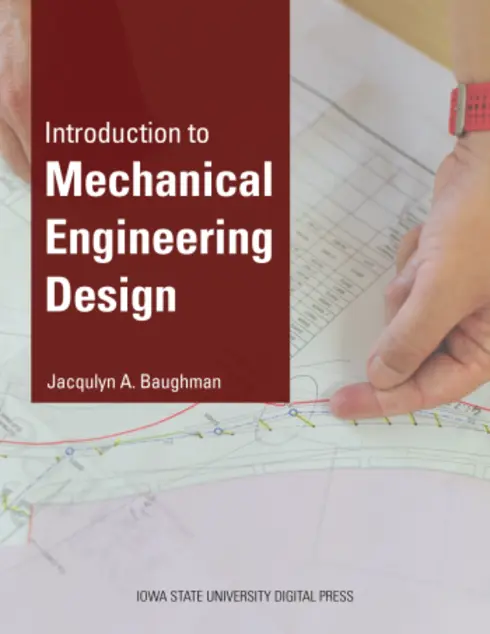
Introduction to Mechanical Engineering Design
![]()
![]()
![]()
![]()
![]()
Jacqulyn A. Baughman, Iowa State University
Copyright Year:
Publisher: Iowa State University
Language: English
Formats Available
Conditions of Use
![]() Attribution-ShareAlike
Attribution-ShareAlike
CC BY-SA
Reviews
Reviewed by Thomas Tortomasi, AutoCAD/ Mechanical Engineering Drawing Design Instructor, Tidewater Community College on 6/19/25
The online text includes six modules, each with tables, short video clips, student activities, and links. I did not see an index or glossary, only a module overview that described features of the publication. read more
![]()
![]()
![]()
![]()
![]()
Reviewed by Thomas Tortomasi, AutoCAD/ Mechanical Engineering Drawing Design Instructor, Tidewater Community College on 6/19/25
Comprehensiveness
The online text includes six modules, each with tables, short video clips, student activities, and links. I did not see an index or glossary, only a module overview that described features of the publication.
Content Accuracy
The text was highly informational and did not seem to have any grammatical errors. The information was ordered in a logical sequence and contained higher level, yet standard engineering vocabulary.
Relevance/Longevity
The text contained standard concepts that can be found in other related materials. Updates can be made easily in the online version as well as the pdf version as long as the original documents were stored.
Clarity
Much of the information/ terminology in the text would be more understandable if the reader had some background in the engineering field. Because it's an "introduction" source, I was expecting a more basic level nature.
Consistency
Consistent terminology and format were used throughout the text.
Modularity
The modules were listed in the introduction, and they were easy to find on the pdf file. Links to the different pdf sections worked and were very helpful.
Organization/Structure/Flow
The information seemed to be in a logical format.
Interface
The internal pdf links worked perfectly. Most of the videos were from YouTube and from various sources. My concern was if the videos became unaccusable at some point it would adversely affect instruction.
Grammatical Errors
I noticed no grammar errors.
Cultural Relevance
I did not notice anything insensitive or offensive, but I didn't see any representation of other ethnicities/ races. I only checked six videos.
CommentsIt looks like a solid text that is easily to maneuver through. It's pretty much what I am used to in the science and engineering field.
Reviewed by Hafizur Rahman, Assistant Professor, The University of Texas Rio Grande Valley on 12/15/24
The book consists of a total of seven modules. The modules are micro-economy kit, define, measure, analyze, design, verify, and report results. Each module has individual chapters. The module and corresponding chapter titles are provided as... read more
![]()
![]()
![]()
![]()
![]()
Reviewed by Hafizur Rahman, Assistant Professor, The University of Texas Rio Grande Valley on 12/15/24
Comprehensiveness
The book consists of a total of seven modules. The modules are micro-economy kit, define, measure, analyze, design, verify, and report results. Each module has individual chapters. The module and corresponding chapter titles are provided as “Contents” at the beginning of the book and are easy to follow.
Content Accuracy
The content is accurate.
Relevance/Longevity
The book was published in 2023, and its contents are up-to-date. It provides the essential elements and key concepts for mechanical engineering design. The current structure of the book allows for updates, i.e., adding any new content easily. Several design examples from real-life scenarios related to thermal and mechanical systems have been provided.
Clarity
The book is written simply, and it is easy to follow. The texts are concise. One good thing about the book is that it uses many practice exercise examples as hyperlinks. The hyperlinks will take you directly to that exercise problem that is easy to follow and do in browsers.
Consistency
At the start of each module, module objectives are clearly stated. Additionally, related assignments, tasks, and grading criteria are also provided. Depending on the module objectives, some modules consist of multiple tasks. Each module is again divided into a few chapters.
Modularity
Yes, the book is easy to follow. The book is mainly divided into modules, and each module is further divided into chapters.
Organization/Structure/Flow
The organization of the book is good. Many images, mechanical drawings, tables, and flow charts have been added, which help readers to understand the texts and concepts.
Interface
I did not notice any significant interfaces. The navigation through PDF is very easy. The book uses many hyperlinks continuously throughout the book. It allows the reader to quickly go through to a more detailed explanation, examples, videos, tests, etc.
Grammatical Errors
I did not notice any significant grammatical errors.
Cultural Relevance
No culturally insensitive or offensive texts have been noticed.
CommentsOverall, the book is written excellently. The book provides the basic ideas and concepts that anyone needs to successfully complete a design project by providing a lot of real-life examples.
Table of Contents
- Introduction 1: Course Description, Objectives, and Module Overview
- Introduction 2: Course Setup and Design Process (DFSS)
- Introduction 3: DMADVR Phases and Tools within the DFSS Process
- Introduction 3a: DMADVR - Test for Understanding Activity
- Module 00 - Micro-economy Kit
- Module 1 - Define
- Module 2 - Measure
- Module 3- Analyze
- Module 4A - Design
- Module 4B - Design Continued
- Module 5 - Verify
- Module 6 - Report Results
- Appendix 1: Accessibility Assessment
About the Book
A collection of readings and exercises aligned with the course, ME 270, Introduction to Mechanical Engineering Design, at Iowa State University. This course provides an overview of mechanical engineering design with applications to thermal and mechanical systems, and an introduction to current design practices used in industry.
About the Contributors
Author
Dr. Jacqulyn A. Baughman, Iowa State University
